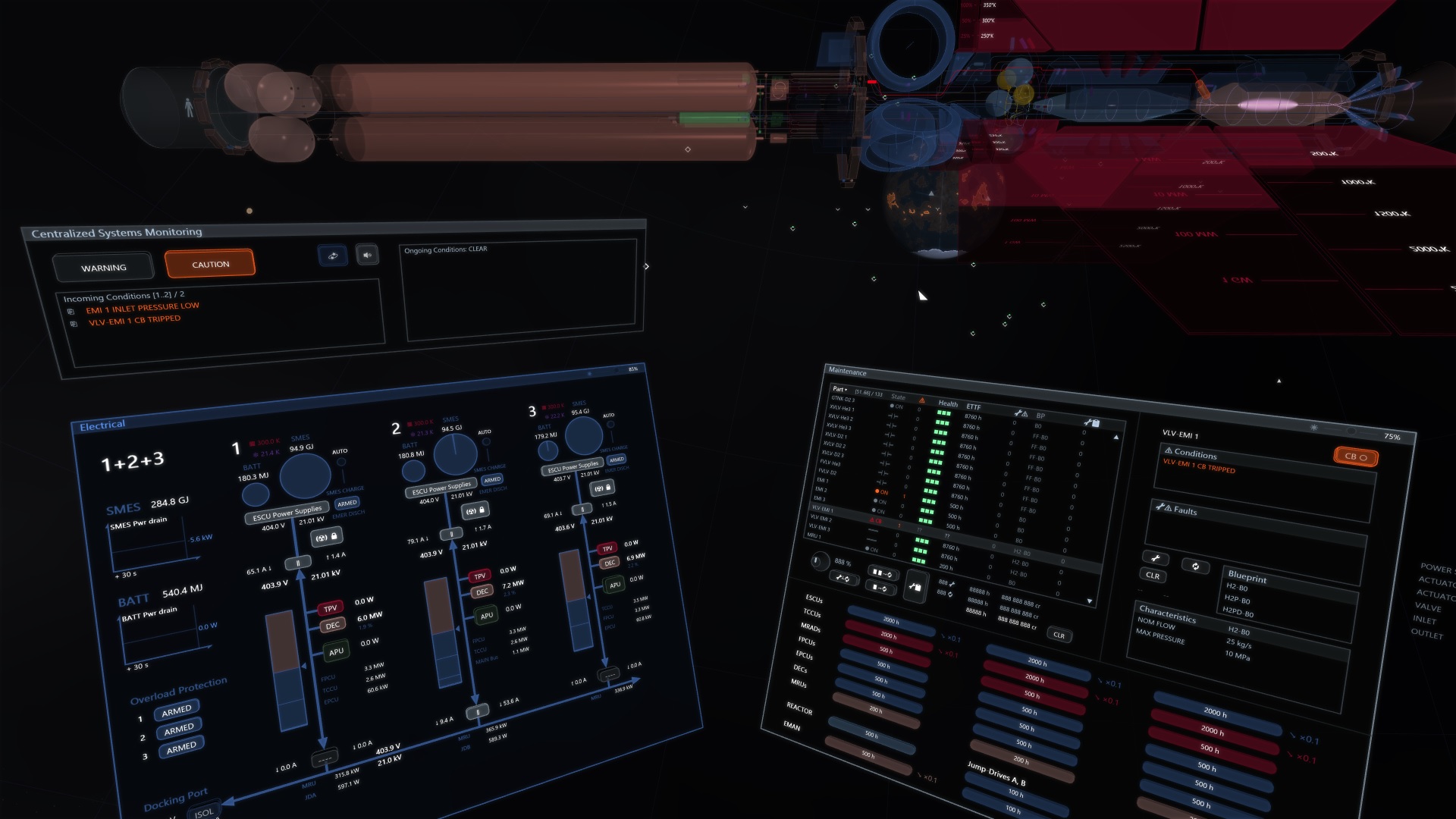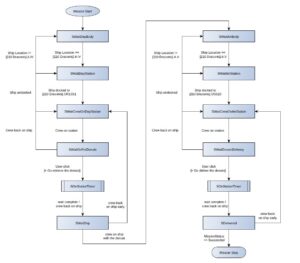The ship is now fitted with a centralized monitoring system, alarms and protections.
After the first pass on the ship’s systems in 2015-2016 I moved to the avionics to start flying as soon as possible! 🙂 However in that incomplete state the power plant was very dangerous and unforgiving. The checklists helped but in effect countless ships have been lost due to a SMES silently getting drained at high time acceleration, or reactors started on the D2 / Helium-3 in the pipes – tank valves left closed – and starving at high power…
Here’s a video presenting the system:
The next work item will consist in getting able to service and repair the ship at stations. And then the development should move to the front section, notably to implement the crew’s life support systems.
Fly safe! 🙂



Looks fantastic! Excited to see more this year.
Thank you for the encouraging words! 👨🔧🙂
Any indication when this game beomes avaiable?
It’s always difficult to give precise estimates, but 2023 should mark the “beginning of the home straight” with the gamification layer. Following this the intent is to factor the new features (primarily the ship’s military equipment) into the mission system on the run and towards the game release.
Awesome !
Thanks for reading! 🙂
Excellent work, as always. Two questions:
1.) Is it possible for the monitoring and alarm systems themselves to fail? If so, how will the user detect and respond to them?
2.) What about failures of the electronic checklist system? I imagine the crew would probably resort to their quick reference handbooks (on paper) then, but since you do not plan on modelling a physical cockpit, what gives?
Ah to be honest for practical reasons a minimum set of key systems just can’t fail. As you mention there’s no physical simulation for the players to fall back to anyway, so their control interface must remain reliable at all times, otherwise the game would become “unplayable” by definition (incidentally the display of the surrounding environment is not such a system, only the control panels and markers are).
Introducing errors in the ship’s diagnostic system is another question. It already features some “unknown state” reporting since the communication bus between the equipment and the central “systems controller” is modeled, with possible loss of contact. However to begin with the data returned to the player will remain accurate so they can act upon it and manage problems. If that happens to be too easy for the most hardcore flight engineers out there then it won’t be too difficult to throw in faulty sensors and nasty intermittent malfunctions 😈🙂
I’ve been waiting for a long time for a detailed space simulator. Great work! Although there was one more that was abandoned, what you came up with is enough to get a glimpse of the future.
Are there any plans to make an old style ship with clickable cockpit buttons?
Thanks for watching! 🙂
Rendering ship interiors convincingly requires a large effort and graphics skills I don’t have, and so being a solo developer I chose to allocate my limited resources to the simulation model instead.
Understood and well pointed.
If I may add two suggestions.
1. In the presentation videos, I noticed that a huge amount of heat is generated (heat that the ship struggles to dump). On the other hand, i noticed that there are basically 3 power sources (batteries, fuel cells and reactor). For fast and short trips efficiency isn’t an issue. But for long and calm trips, would it be possible to harness the excessive reactor heat and turn it to power so that I would leave nothing to waste. That way, I would accelerate up to a point, cruise on inertia part of the journey while “sleeping” or “on fast fwd mode” and I wouldn’t use up battery power or ride in complete blackout.
2. A fuel cell generates power while generating water.
While the reactor is running, the water could either be dumped for cooling the ship or dissociated back to H2 and O2 (and put back in the tanks as compressed gas) using part of the excessive heat.
Ah that latest video was mostly with the reactor running at full power during a main engine burn. However these rarely exceed 4 hours and most of the time the reactor is back to idle power while the ship is coasting on its trajectory. For a better overview of the various flight phases you might want to watch that video from Deephack
• The main electrical generators are magnetohydrodynamic (“DEC”) and convert the thermal energy in the exhaust plasma in electricity.
• Part of the heat from the reactor is indeed retrieved by thermalphotovoltaic cells (“TPV”) but they work on the black-body radiation so at very high power and T° only.
• The ship’s main superconducting magnetic energy storage (“SMES”, part of the “ESCU” main electrical management system) are primarily used as buffers: they power the ship during the departures and approaches when the reactor is down for safety, and will absorb a temporary high-power consumption spike (including a reactor start). However they are supposed to be charged at all times when the reactor is running (the video was about an abnormal situation in that regard).
• Finally the auxiliary fuel cells (“APU”) are supposed to be off as soon as the reactor is started. Their main purpose is safety and to ensure that a ship may be able to restart its reactor in deep space with its SMES’s initially discharged. Incidentally the hot vapor from the cells is already vented into space to get rid of the associated heat losses.
You’ll find more information about the ship’s systems here: Electrical System, Thermal Control (although these are a bit out of date since the last upgrades!).
Every update gets me more excited for a really neat space sim.
Have you thought of having a non-compliant way to run systems? Not sure that makes sense, but I am referring to essentially jury rig mechanics. If you have a component damaged/in-op will there be other options?
In the video you showed a little of this with the DEC failure and running 2 SMES on the bus. Will there be more extreme versions of this? Like odd ways to start/stop the reactor?
I am not familiar with advanced systems like these so I can’t speculate or make any suggestions on what is possible.
Thanks for watching 🙂
Well that’s not “jury rigging” really but from what I have seen so far each failure requires to be quite creative with the redundancy circuits already. I implemented the components’ failure modes, the ship’s systems redundant layout and the underlying physics simulator rather independently actually, i.e. nothing is scripted in there.
And so I’m only starting to effectively deal with faults in-game! The process requires to understand the problem based on the diagnostic report, evaluate the damage and effect on the current operation mode and then devise a workaround. And that is much less straightforward that I imagined it would be to be honest! 🙂 Speaking about the reactor, while being obviously constrained its operation mode can be significantly altered through its configuration sliders. So for instance the problem in the video could have been solved by making it less demanding on the plasma confinement units which happen to be primary power consumers and heat generators… at a trade-off with the neutron dose rate very likely.
Hi, David! Just wanted to check on the progress on the ASG game. Thanks.